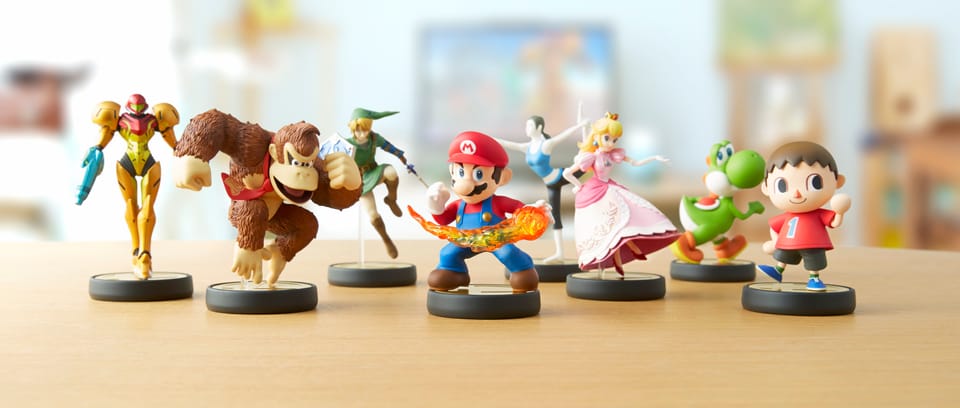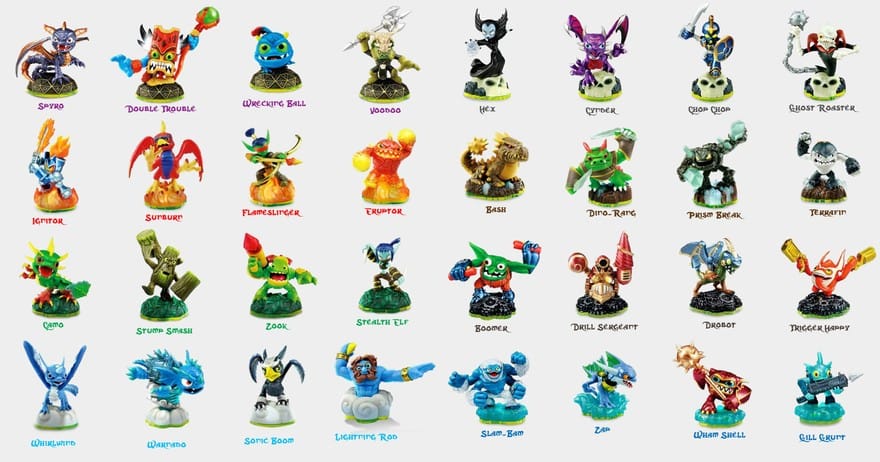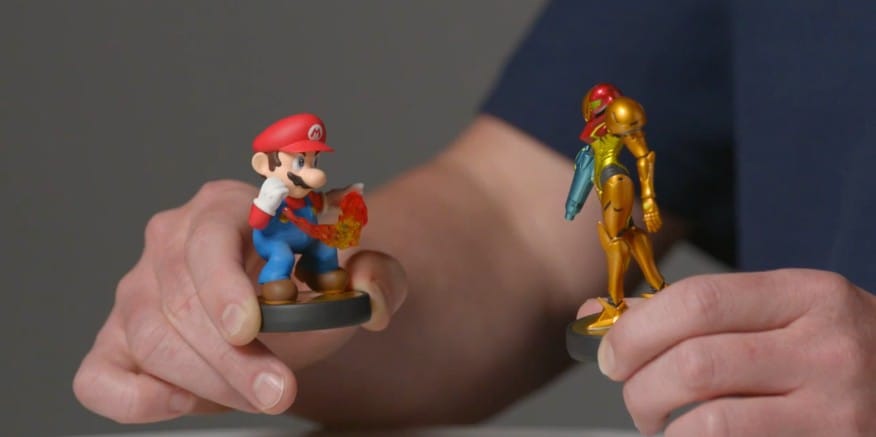The curious evolution of Nintendo’s new "amiibo"

On the top shelf of my bookcase is a row of toys. Not action figures, really, nor are they collectibles from a cherished franchise or even dolls to manipulate. I think of them more as totems: each a small physical object that holds a bit of magic inside. Some contain the past (a square plaque of a lion attained in Rome); some contain a place (a jazz musician figure bought off the street in Manhattan). Others exude filial love, like the plush Peep chick my mom sent in an Easter package, her youngest son hundreds of miles away. One is a scary plastic witch whose eyes glow red when you push her stomach while an embedded speaker screams in anguish. I used that in a class I taught once. I don’t anymore. But there it sits, reminding me of a past boldness, pedagogy be damned.
All of this information, this manufactured bit of soul, I’ve imbued into these figures myself. The Just Born company out of Bethlehem, PA, makers of Peeps, did not stitch together this yellow stuffed baby marshmallow chicken with my mother in mind. But she’s there inside that handful of cotton and cloth.
Still: what if you could interact in a meaningful way with a small toy that not only came with its own identity, but would remember and evolve into a unique toy all your own? This is the vision behind Nintendo’s new line of figures they’re calling “amiibo.”
There is value in seeing a toy in your hand spring to action on your television.
Activision’s Skylanders games didn’t invent the notion of toys coming to life; long before Pixar’s Toy Story we suffered through Furby, and Tamagotchi, and Teddy Ruxpin. But Skylanders was the first to successfully mesh videogames with the world of action figures to such a degree. Without buying the toy, you simply can’t play with that character in the game. Forget what many consider an exploitative pricing model: To the millions of kids (and adults) who swoon over the latest Skylanders figures, and all those who’ve lapped up Disney’s take on the “toys-to-life” category (as Activision coins it) with Disney Infinity, there is value in seeing a toy in your hand spring to action on your television.
Nintendo is entering a bit late into a somewhat crowded battlefield. But their tanks wield big guns. Nintendo’s stable of beloved characters will draw in a certain level of fan (remember: short for “fanatic”) that just wants the figurine for their collection. To truly stand out and become the massive mainstream success President Iwata hopes for will require an inventive take on an established paradigm.
Already, parents and consumers must have figure fatigue. Each Skylanders game requires a new set of toys. This will be the fourth consecutive year for Activision’s hit franchise. That’s a lot of plastic shoved aside for more plastic: planned obsolescence masquerading as collectables.

Here is where “amiibo” (pronounced ah-ME-bo) feels different. Each figure can be used across multiple titles. Buy a Mario amiibo and use it in Super Smash Bros., but also for Mario Kart 8 and the upcoming Captain Toad’s Treasure Tracker. This toy is sociable enough to play with others. Little has been revealed, but the possibility for one figure to react differently in one game depending on how else it has been used is an intriguing bit of voodoo: These figures have memories. And they’ll change depending on what they do and where they’ve been. Just like us.
This is because each figure not only holds information to be used by the game, but can have data written directly to the embedded chip. That’s an inelegant way to say it’s dynamic, not some static hunk of silicon. Each figurine begins the same way. But over the lifetime of the player’s interactions with it, the figure will grow alongside the player. When Bill Trinen, Senior Marketing Manager at Nintendo of America, introduced the amiibo concept in a recently-released video, he used words more suitable to describing a friend than a toy.
In the first game to use amiibo, Super Smash Bros. for Wii U, you don’t unlock playable characters by buying the toy. Instead, each figure “comes to life” in the game and fights on its own. “Each figure contains the spirit of the character they represent,” he said, adding that each “can act as your alter ego, partner or rival.” You can sit back and cheer it on, or fight against it. What seems like a strange, unintuitive decision—to make this toy you buy a passive add-on to the game—appears at first blush like a brilliant tactic. Each character appears to have its own little lifeforce. It doesn’t even need you to pull the strings; you simply play against, or alongside, your new toy.
Nintendo, better than any other videogame company, understands how to forge relationships with their fans.
Trinen doesn’t say, “Buy figures of your favorite Nintendo characters!” Instead he explains how you can “form your own unique bond with them.” Nintendo, better than any other videogame company, understands how to forge relationships with their fans. The “amiibo” concept is a natural extension of this ability.
“When I was young I spent a lot of time imagining who would win if my toys got in a fight,” Trinen says, connecting amiibo and Smash Bros. as extensions of that childhood dream many of us have had. The risk is that players won’t want to watch these dream scenarios play out; we want to put on the gloves ourselves.
It’s too soon to tell whether the figurines will provide novel and interesting ways to play, or are received as callow cash-grabs. But Nintendo’s choice to pair the first line-up of toys with their big home title for the holidays is a sign of confidence. How these figures will interact with other games has yet to be announced; perhaps others will offer the toys a more active participation. But how active can they be? After all, they will only and always be a plastic figure, sitting on my shelf. They’re just toys. Right?

I remember fondly the playthings of my youth. If Nintendo succeeds in creating a figure that remembers me, as well, my first amiibo might just be the next one to join that line-up of bookshelf souvenirs, each holding a memory. This time I won’t have to recall a story or background to explain its worth. What we’ve gone through will be there, inside. Almost like a spirit. Or a soul.



